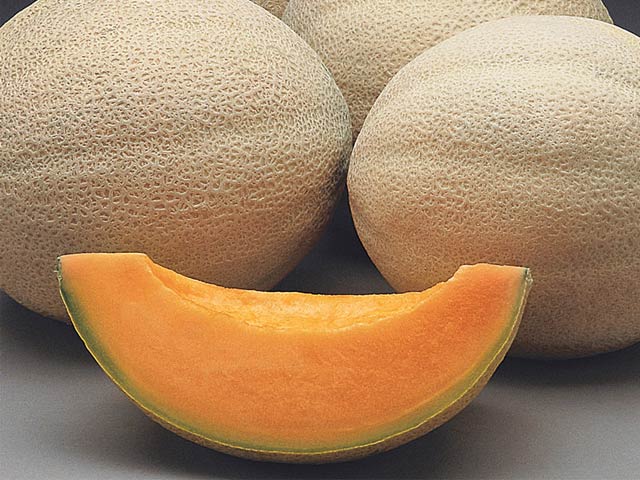Wow Kent: The botanical name of summer is Cucumis Melo.
Historical background: (Historical background)
Garma is the sweet taste and easy digestible fruit of summer.
It is from the melon family. Another fruit of this species is Sarda. Its pulp, bark, seeds are all useful. It is also used as fruit, salad, ice cream and custard.
The color of the fruit is yellow, the peel is hard and it has spots. It looks like a melon on a vine-like plant that often takes the form of a small tree. Sandy soil is suitable for its cultivation. The higher the heat, the faster it becomes a sweet, sweet and uniquely aromatic fruit. Its weight ranges from one to five kilograms i.e. 1 to 11 pounds.
Garma was introduced from Armenia. Its name was derived in the 18th century by the French Canta Lupe from the Italian Canetolo Poe’s Kinston Ridge.
By 1890, it had become a commercial fruit in the United States.
Types: There are about 22 types of garma. However, there are five which are very popular and available in the market.
1. European Summer: This variety is said to have no connection to Europe but to have arrived in Europe from Africa or Asia. This is the most popular type. Its pulp is sweet and musky. It has light green lines running from top to bottom. It can also be eaten raw or as a salad.
2. North American summer: North American summer is similar to European summer. It is characteristically sweet juicy and tender. Its pulp is orange inside. Its skin is softer than the European summer.
3. French Summer: It is said to have originated from the territory of France. Western France in particular is famous for its cultivation. It is also called (Poitus Charentus). This type is smaller than others. Its exterior is creamy and gray. The pulp is orange inside and unusually sweet. Its texture, taste and aroma are considered excellent. People consider it the best type. Its size is equal to a small hair.
4. Japanese summer: It is known for its shapely appearance with exceptional good looks and smooth skin. This type is very expensive and is usually given as a gift. It is bought by the upper class for their guests. Its pulp is also orange. It is exceptionally delicious. The Japanese grow this variety with great care.
5. Asian Summer: It is also commonly called Persian Melon. It is musky and sweet with a crispy texture. The color of the skin is green or yellow. Its pulp is also light orange. It is cultivated in East Asia. Phylogenetic studies have revealed that it originated in India. Then it was introduced to China and from there to Korea and Japan. Its taste has been compared to honey. It contains 90% water. It can be eaten with peel and seeds.
Gross Production: According to The Food and Agriculture Organization Corporate Statistics Database (FAOSTAT), its average production was 27 million metric tons as of 2018, with China accounting for 46 percent of production. Other heat producing countries include Turkey, Iran, Egypt, India, United States.
Dietary intake:According to the USDA, the United State Department of Agriculture, its nutritional value in 100 grams is as follows.
Calories (Kcl) 34
Water 90%
Carbohydrates (Carbohydrates) 8.16 grams
Sugar 7.16 grams
Dietary fiber 0.9 grams
Fat (fat) 0.19 grams
Protein (Protin) 0.84 grams
(Vitamins) Amount (Quantity) Daily Requirement DV %
Vitamin A (Vitamin A) 169 micrograms 21%
Betacarotene 2020 micrograms 19%
Lutin zeaxanthin (Lutin zeaxanthin) 26 micrograms
Thiamine B1 (ThiamineB1) 0.041mg 4%
Riboflavin B 2 grams (RiboflavinB2)) mg
(2% Niacin B3) 0.334 mg 5%
Pantothenic acid B5 (Pantothenic acidB5) 0.105 mg 2%
Vitamin B (VitaminB6) 0.072 mg 6%
Folate B9 (folateB9) 21 micrograms 6%
Choline (Choline) 7.6 mg 2%
Vitamin C (Vitaminc) 36.7 mg 44%
Vitamin K (vitamink) 2.5 micrograms 2%
Minerals Quantity Daily Requirement DV%
Calcium (calcium) 9 mg 1%
Iron (iron) 0.21 mg 2%
Magnesium 12 mg 3%
Manganese (manganese) 0.041 mg 2%
Phosphorus (phosphorous) 15 mg 2%
Potassium (potassium) 267 mg 6%
Sodium (sodium) 16 mg 1%
Zinc (zinc) 0.18 mg 2%
Medical Benefits: Let’s highlight some of its medical benefits.
1. To control blood pressure
The fiber, potassium, vitamin C, and choline in kale are all heart-healthy. According to experts, blood pressure can be controlled by eating foods rich in potassium. According to the American Heart Association, an adult should consume 4,700 milligrams of potassium per day to maintain a healthy cardiovascular system. Fiber helps reduce bad cholesterol levels in the body.
2. To control asthma
Consuming a large amount of beta-carotene in the form of vitamin A can prevent the development of diseases such as asthma in a person’s life. Beta-carotene is found in yellow and orange fruits. For example, apricots, grapefruit, oranges, peaches, pitas and mangoes. In addition to vitamin C, which controls asthma, adults should consume 75 to 90 mg of vitamin C per day.
3. Prevention of cancer
It contains beta-carotene, lutein, zeaxanthin, tocopherol, selenium and other antioxidants that prevent cell damage caused by oxidative stress. It plays an important role in the prevention of colon, prostate, lung and other types of cancer.
4. Skin and hair
Vitamin C and vitamin A are essential for all body tissues, including skin and hair. A range of minerals and vitamins prevent hair loss. Vitamin C helps in the production of natural collagen. They also protect from the strong rays of the sun.
5. Teeth and bones
Calcium and selenium are abundant in summer.
100 grams of garma contains 15 mg of calcium which makes teeth and bones healthy.
6. Signs of premature aging
Heat reverses the signs of premature aging. This fruit is rich in collagen which reduces the signs of aging. Facial blemishes and wrinkles are reduced. Skin feels fresh and supple.
7. Dehydration
90% of water is available in summer which makes up for the lack of water in summer. It is an excellent source of minerals and vitamins.
8. Eye health
It also contains vitamin A and beta-carotene, which play an important role in eye health and vision.
People who have poor eyesight should consume this fruit in summer.
9. Type 2 diabetes
The risk of type 2 diabetes can be reduced by consuming ghee. With its use, the sugar level in patients remains normal.
10. To boost immunity
Vitamin C is the best fruit to boost immunity.
It protects against viral, seasonal diseases and infections.
11. Kidney stones
Garma is the unique fruit that prevents the formation of kidney stones. Its high water content flushes out waste from the kidneys, keeping the kidneys healthy.
12. For pregnant women
According to nutritionists, this fruit is very useful for women’s health. The presence of folic acid in it helps to eliminate excess sodium, which has positive effects on health.
13. Mental stress
By eating hot food, the right amount of oxygen is delivered to the blood, which reaches the brain in a balanced amount, due to which a person feels lighter, which reduces mental pressure and nervous tension.
14. Weight loss
It is low in fat and carbohydrates, which helps in weight loss. If you want to lose weight under a diet plan, eating gram in summer is more beneficial than other foods and vegetables.
15. Muscle strength
It contains high amount of potassium which strengthens the muscles. It strengthens the affected muscles.
16. Improves digestion
The amount of water is more in summer. It also contains fiber which prevents constipation and promotes healthy digestion. It improves digestive function.
Precautions:
Follow the following precautions while eating hot food.
* Excessive consumption may cause diarrhoea.
* Stomach pain and gas may occur if you have allergies.
* If you suffer from kidney disease, too much of it can cause problems because of its high potassium content.
* Eating too much heat can cause kidney disease Hyperkalemia.
(function(d, s, id){
var js, fjs = d.getElementsByTagName(s)[0];
if (d.getElementById(id)) {return;}
js = d.createElement(s); js.id = id;
js.src = “//connect.facebook.net/en_US/sdk.js#xfbml=1&version=v2.3&appId=770767426360150”;
fjs.parentNode.insertBefore(js, fjs);
}(document, ‘script’, ‘facebook-jssdk’));
(function(d, s, id) {
var js, fjs = d.getElementsByTagName(s)[0];
if (d.getElementById(id)) return;
js = d.createElement(s); js.id = id;
js.src = “//connect.facebook.net/en_GB/sdk.js#xfbml=1&version=v2.7”;
fjs.parentNode.insertBefore(js, fjs);
}(document, ‘script’, ‘facebook-jssdk’));


